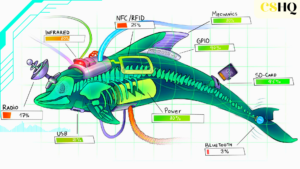Top 50 Potential Cybersecurity Interview Questions for a Internship in 2023: Freshers

Some tips on how to prepare before attending the internship interview:
- Review the basics: Make sure you have a good understanding of the fundamentals of cybersecurity, including common threats and vulnerabilities, security controls, and industry best practices.
- Research the company: Learn about the company you are interviewing with, including its mission, values, and current projects. This can help you tailor your responses to the company’s specific needs and priorities.
- Review the job description: Study the job description carefully and make sure you have a good understanding of the specific skills and qualifications the employer is looking for.
- Practice your responses: Practice responding to common interview questions, both technical and non-technical. Be prepared to provide examples of your experience or knowledge in each area.
- Demonstrate your passion for cybersecurity: Employers want to see that you are genuinely interested in the field and motivated to learn and grow. Be prepared to discuss your interest in cybersecurity and any related projects or activities you have pursued outside of school or work.
- Be confident but humble: Don’t be afraid to showcase your skills and knowledge, but also be willing to admit when you don’t know something and express a willingness to learn.
- Dress appropriately: Dress professionally for the interview, even if it is a virtual interview. A good rule of thumb is to dress as you would for an in-person interview.
- Bring a copy of your resume: Bring a copy of your resume and any relevant certifications or training materials you have completed.
- Follow up after the interview: Send a thank-you note to the interviewer or HR representative to express your appreciation for the opportunity and reiterate your interest in the position.
Top cybersecurity interview questions for 2023:
1. What motivated you to pursue a career in cybersecurity?
Answer: I am interested in the field of cybersecurity because I believe that it is crucial to protecting sensitive information from cyberattacks. Cybersecurity is an essential component of ensuring that data and systems remain safe and secure.
2. Can you describe what a cyberattack is and what it involves?
Answer: A cyberattack is a malicious attempt by someone to gain unauthorized access to a computer system or network. It can involve stealing data, infecting systems with malware, or disrupting normal operations of the system or network.
3. What do you think are the most significant cybersecurity threats facing organizations today?
Answer: Some of the most significant cybersecurity threats include phishing attacks, malware, ransomware, and social engineering attacks. These attacks can lead to data breaches and financial losses for organizations.
4. What do you think are the most important skills for a cybersecurity professional?
Answer: Some of the most important skills for a cybersecurity professional include technical knowledge of security concepts and technologies, critical thinking and problem-solving skills, and strong communication and collaboration abilities.
5. Can you explain the difference between a virus and a worm?
Answer: A virus is a type of malware that attaches itself to an executable file or program and replicates itself when the file is opened. A worm, on the other hand, is a standalone program that replicates itself and spreads across a network without the need for human intervention.
6. Can you describe what firewalls are and how they work?
Answer: A firewall is a security device that monitors and controls incoming and outgoing network traffic based on a set of rules. It acts as a barrier between a network and the internet, preventing unauthorized access to the network.
7. Can you explain what a denial-of-service (DoS) attack is?
Answer: A DoS attack is a type of cyberattack in which a hacker attempts to overload a server or network with traffic or requests, causing it to become unavailable to legitimate users.
8. What is your understanding of risk management in cybersecurity?
Answer: Risk management involves identifying potential threats to an organization’s data and systems and implementing strategies to mitigate those risks. This can include measures such as implementing access controls, performing regular backups, and conducting vulnerability assessments.
9. Can you explain how encryption works?
Answer: Encryption is a method of securing data by converting it into a coded format that can only be read by authorized users with the correct decryption key. Encryption can be used to protect sensitive data such as passwords, credit card numbers, and other personally identifiable information.
10. Have you ever conducted a vulnerability assessment? Can you describe the process?
Answer: A vulnerability assessment involves identifying potential vulnerabilities in a system or network, prioritizing those vulnerabilities based on their severity, and developing a plan to address those vulnerabilities.
11. Can you describe the process of incident response?
Answer: Incident response is the process of identifying and responding to cybersecurity incidents, such as data breaches or malware infections. This can involve steps such as identifying the source of the incident, containing the incident to prevent further damage, and conducting a post-incident review to prevent similar incidents from occurring in the future.
12. What is your experience with cybersecurity regulations such as HIPAA or GDPR?
Answer: HIPAA and GDPR are cybersecurity regulations designed to protect sensitive personal data. Compliance with these regulations requires implementing security measures to meet their requirements.
13. Can you explain what a phishing attack is?
Answer: A phishing attack is a type of cyberattack in which a hacker sends a fraudulent email or message to trick the recipient into revealing sensitive information such as passwords or personal data.
14. Can you describe what multi-factor authentication is and why it’s important?
Answer: Multi-factor authentication is a security measure that requires users to provide multiple forms of identification to access a system or network, such as a password and a security token or biometric data. It’s important because it provides an extra layer of security and makes it more difficult for attackers to gain unauthorized access to a system or network.
15. Can you explain the concept of privilege escalation in cybersecurity?
Answer: Privilege escalation is the process of gaining elevated access privileges to a system or network. This can occur when an attacker gains access to a lower-level user account and uses it to gain additional privileges or when a vulnerability in a system is exploited to gain higher-level access.
16. Have you ever conducted a penetration test? Can you describe the process?
Answer: A penetration test is a simulated cyberattack on a system or network to identify vulnerabilities and potential attack vectors. The process involves identifying targets, performing reconnaissance, identifying potential vulnerabilities, and attempting to exploit those vulnerabilities to gain access to the system.
17. Can you explain what a honeypot is and how it’s used in cybersecurity?
Answer: A honeypot is a system or network designed to attract and detect potential attackers. It’s used to gather information about attacker behavior and to divert their attention away from the actual system or network being protected.
18. Can you describe the process of patch management in cybersecurity?
Answer: Patch management involves keeping systems and software up-to-date with the latest security patches and updates to prevent vulnerabilities from being exploited by attackers.
19. What is your understanding of network segmentation in cybersecurity?
Answer: Network segmentation is the process of dividing a network into smaller subnetworks or segments to improve security and performance. It can be used to isolate sensitive data and systems from the rest of the network and to limit the potential impact of a security breach.
20. Can you explain what a Man-in-the-Middle (MitM) attack is?
Answer: A MitM attack is a type of cyberattack in which an attacker intercepts and modifies communications between two parties to steal data or compromise the security of the communication.
21. Can you describe the process of threat modeling in cybersecurity?
Answer: Threat modeling involves identifying potential threats to a system or network and developing strategies to mitigate those threats. This can involve identifying attack vectors, assessing the severity of potential threats, and developing countermeasures to prevent or mitigate those threats.
22. Can you explain the concept of social engineering in cybersecurity?
Answer: Social engineering is the use of psychological manipulation to trick users into divulging sensitive information or performing actions that compromise the security of a system or network. Examples of social engineering tactics include phishing attacks and pretexting.
23. What is your experience with incident management tools such as Splunk or SIEM?
Answer: Incident management tools such as Splunk or SIEM are used to detect and respond to cybersecurity incidents. Experience with these tools involves understanding how to use them to identify potential incidents, analyze logs and data, and respond to incidents as they occur.
24. Can you explain what a distributed denial-of-service (DDoS) attack is?
Answer: A DDoS attack is a type of cyberattack in which multiple systems are used to flood a target system or network with traffic or requests, causing it to become unavailable to legitimate users.
25. What is your experience with cybersecurity risk assessments?
Answer: Cybersecurity risk assessments involve identifying potential risks to a system or network and developing strategies to mitigate those risks. Experience with risk assessments involves understanding how to identify potential vulnerabilities and threats, assess the severity of those threats, and develop countermeasures to mitigate those threats.
26. Can you describe the process of log management in cybersecurity?
Answer: Log management involves collecting, storing, and analyzing logs and data from various sources to identify potential security incidents or vulnerabilities. This can involve configuring logging settings on systems and applications, aggregating and centralizing log data, and using analysis tools to identify potential security issues.
27. Can you explain the concept of encryption in cybersecurity?
Answer: Encryption is the process of encoding information in a way that only authorized parties can access it. It involves using a cryptographic algorithm to convert plaintext data into ciphertext that can only be decrypted using a key or password.
28. What is your understanding of the concept of threat intelligence in cybersecurity?
Answer: Threat intelligence involves gathering and analyzing data about potential cyber threats and using that information to proactively defend against those threats. This can involve collecting data from internal systems and external sources, such as social media and dark web forums, and using that information to identify potential threats and develop strategies to mitigate them.
29. Can you describe the process of vulnerability scanning in cybersecurity?
Answer: Vulnerability scanning involves using automated tools to identify potential vulnerabilities in a system or network. This can involve scanning systems for known vulnerabilities or testing systems for common configuration errors and misconfigurations.
30. What is your understanding of the concept of access control in cybersecurity?
Answer: Access control involves controlling who has access to a system or network and what actions they can perform. This can involve implementing authentication and authorization mechanisms to verify user identity and restrict access to sensitive data and resources.
31. Can you explain the concept of security information and event management (SIEM)?
Answer: SIEM involves collecting and analyzing security-related data from various sources, such as system logs, network traffic, and security tools, to identify potential security incidents and vulnerabilities. It can be used to centralize and correlate security data from multiple sources and to provide real-time alerts and notifications for potential security incidents.
32. Can you describe the process of network traffic analysis in cybersecurity?
Answer: Network traffic analysis involves monitoring and analyzing network traffic to identify potential security incidents or vulnerabilities. This can involve analyzing network protocols and traffic patterns to identify potential anomalies and indicators of compromise.
33. What is your understanding of the concept of security assessment in cybersecurity?
Answer: Security assessment involves evaluating the overall security posture of a system or network to identify potential vulnerabilities and develop strategies to mitigate those vulnerabilities. This can involve conducting penetration tests, vulnerability assessments, and risk assessments.
34. Can you explain the concept of intrusion detection in cybersecurity?
Answer: Intrusion detection involves monitoring systems and networks for potential security incidents or anomalies and alerting security teams to potential threats. This can involve using automated tools to analyze system logs and network traffic for potential indicators of compromise and suspicious activity.
35. Can you describe the process of incident response in cybersecurity?
Answer: Incident response involves the process of identifying, investigating, and responding to potential security incidents. This can involve isolating affected systems, containing the incident, and mitigating the potential impact of the incident on the organization.
36. What is your understanding of the concept of application security in cybersecurity?
Answer: Application security involves securing software applications and systems from potential threats and vulnerabilities. This can involve implementing secure coding practices, testing applications for potential vulnerabilities, and implementing secure development and deployment processes.
37. Can you explain the concept of threat hunting in cybersecurity?
Answer: Threat hunting involves proactively searching for potential security threats and vulnerabilities in a system or network. This can involve using advanced analytics and data analysis techniques to identify potential indicators of compromise and suspicious activity.
38. Can you describe the process of security incident response planning in cybersecurity?
Answer: Security incident response planning involves developing a comprehensive plan for identifying, responding to, and recovering from potential security incidents. This can involve identifying key stakeholders and response team members, defining incident response processes and procedures, and developing communication plans for incident reporting and response.
39. What is your understanding of the concept of cloud security in cybersecurity?
Answer: Cloud security involves securing data and applications that are hosted in cloud environments. This can involve implementing security controls and monitoring solutions to protect against potential threats and vulnerabilities in cloud infrastructure.
40. Can you explain the concept of identity and access management (IAM) in cybersecurity?
Answer: IAM involves managing user identities and access to systems and data within an organization. This can involve implementing authentication and authorization mechanisms, enforcing access controls and policies, and monitoring user activity to ensure compliance and security.
41. What is your understanding of the concept of threat modeling in cybersecurity?
Answer: Threat modeling involves analyzing a system or application to identify potential threats and vulnerabilities and developing strategies to mitigate those risks. This can involve identifying potential attack vectors, analyzing system architecture and design, and developing security controls to address identified risks.
42. Can you describe the process of network segmentation in cybersecurity?
Answer: Network segmentation involves dividing a network into smaller subnetworks to improve security and manageability. This can involve implementing firewalls and access controls to restrict traffic between network segments and to prevent potential threats from spreading across the network.
43. What is your understanding of the concept of security operations center (SOC) in cybersecurity?
Answer: A SOC is a centralized facility for monitoring and responding to potential security incidents and threats. It can involve using advanced analytics and data analysis techniques to identify potential threats and vulnerabilities and to coordinate incident response efforts across an organization.
44. Can you explain the concept of security governance in cybersecurity?
Answer: Security governance involves developing policies, procedures, and standards for managing and securing information assets within an organization. This can involve defining roles and responsibilities, establishing security controls and compliance requirements, and monitoring and measuring the effectiveness of security controls.
45. Can you describe the process of security awareness training in cybersecurity?
Answer: Security awareness training involves educating employees and stakeholders on security best practices and policies to reduce the risk of security incidents and vulnerabilities. This can involve providing training on phishing and social engineering attacks, password hygiene, and safe browsing practices.
46. What is your understanding of the concept of threat hunting in cybersecurity?
Answer: Threat hunting involves proactively searching for potential security threats and vulnerabilities in a system or network. This can involve using advanced analytics and data analysis techniques to identify potential indicators of compromise and suspicious activity.
47. Can you explain the concept of security incident response planning in cybersecurity?
Answer: Security incident response planning involves developing a comprehensive plan for identifying, responding to, and recovering from potential security incidents. This can involve identifying key stakeholders and response team members, defining incident response processes and procedures, and developing communication plans for incident reporting and response.
48. Can you describe the process of security risk management in cybersecurity?
Answer: Security risk management involves identifying potential security risks and vulnerabilities within an organization and developing strategies to mitigate those risks. This can involve conducting risk assessments, developing risk management plans, and implementing risk management controls and monitoring solutions.
49. What is your understanding of the concept of digital forensics in cybersecurity?
Answer: Digital forensics involves the process of collecting, analyzing, and preserving digital evidence to investigate potential security incidents or crimes. This can involve using specialized tools and techniques to recover deleted data, analyze network traffic, and identify potential sources of security incidents.
50. Can you explain the concept of zero-trust security in cybersecurity?
Answer: Zero-trust security is a security model that involves treating all users and devices as potential threats and requiring authentication and authorization for all access to systems and data. This can involve implementing strict access controls and policies, monitoring user activity, and using advanced analytics and data analysis techniques to identify potential threats and vulnerabilities.
Bonus Tip for Cybersecurity interview questions: Don’t even think of starting a career in cybersecurity if you do not understand this!
What is CIA triad? Why is it the pillar of information security?
The CIA triad is a fundamental model of information security that consists of three core principles: confidentiality, integrity, and availability. These principles form the foundation of modern information security practices, and they are essential for ensuring that information is protected against a wide range of threats and risks.
Here’s a breakdown of each component of the CIA triad:
- Confidentiality: Confidentiality refers to the protection of sensitive information from unauthorized disclosure or access. This can include personal information, trade secrets, financial data, and other types of sensitive information that could cause harm if accessed by unauthorized individuals.
- Integrity: Integrity refers to the protection of information from unauthorized modification or destruction. This ensures that information is accurate, reliable, and trustworthy, and that it has not been tampered with or altered in any way.
- Availability: Availability refers to the ability to access information and resources when needed. This ensures that information is accessible and usable by authorized individuals when required, and that it is not inaccessible due to technical issues, attacks, or other factors.
The CIA triad is considered the pillar of information security because it provides a comprehensive framework for understanding the fundamental goals of information security. By addressing each of these principles, organizations can develop effective security policies and practices that ensure the confidentiality, integrity, and availability of their information assets. Without these principles, information security would be incomplete, and organizations would be unable to adequately protect their critical information assets.
Checkout Edureka to learn more advanced topics.





1 thought on “Top 50 Potential Cybersecurity Interview Questions for a Internship in 2023: Freshers”
Comments are closed.